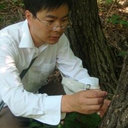[Effects of Pingyangmycin albumin microspheres on sclerostenosis of the rabbit central auricular arteries].
Palabras clave
Abstracto
OBJECTIVE
The aim of this study was to investigate the mechanism of Pingyangmycin-albumin microspheres (PYM-AMS) acted on the rabbit central auricular arteries.
METHODS
In the study of randomized block design, 24 Japanese white rabbits were divided into 4 groups, 6 rabbits in each group. The animals were put on the operation table after being anaesthetized by intramuscular injection of Xumianxin (0.2 ml/Kg) and the interior division was blocked to stop drug liquid get into the interior ear. After being sterilized with 75% alcohol, No.1(PYM hydrochloride injection+0.9% NaCl), No.2(PYM+soybean oil), No.3(PYM-AMS+soybean oil) liquids which contained PYM 5mg/ml were injected into the central auricular arteries of the animals about 30 seconds (0.26 ml/per ear), respectively. Then these vessels were examined histologically after 2,7, 14, 21 days respectively.
RESULTS
After injection, in PYM+0.9% NS control group (No.1 liquid), the ears and vessels had no significant changes. In PYM+soybean oil control group (No.2 liquid), at the 2nd day, the endothelial cells were mild swollen. At the 7th day, some endothelial cells were dropped off. At the 14th day, the central auricular arteries had mild change, but the blood flow was not blocked. At the 21st day, the wall of the central auricular artery had more layers, especially on the intima, but the lumen was still obvious. A few of endothelial cells were proliferative. In PYM-AMS group(No.3 liquid), the blood was not resumed at once, and there was some oil in the vessels. At the 1st day, the injection site was mild swollen, and small thrombosis was observed in small vessels. At the 7th-14th day, the central auricular arteries were narrowed, but the blood could be observed. At the 21st day, the vessels had sclerostenosis, and the blood flow was blocked, but no scar and necrosis were observed. Under light microscopy, at the 2nd day, the endothelial cells were mild swollen and small vessels were embolized by PYM-AMS. At the 7th day, the endothelial cells were mild swollen. At the 14th day, the endothelial cells were proliferative and the wall of the central auricular artery had more layers. The lumen of the central artery changed mildly, while the surface of PYM-AMS was absorbed. At the 21st day, the wall of the central auricular artery was proliferative obviously and the artery became sclerostenosed, while cell division was observed. The PYM-AMS was obviously absorbed and some artery was sclerostenosed, while the wall of small vein was proliferative, too. The proliferative intima was proved to be muscle cells with Masson stain and van Gieson's stain. There were many smooth muscle cells, fibroblasts, myofibroblasts in the original blood vascular lumen on the 21st day under electron microscopy.
CONCLUSIONS
Pingyangmycin nonspecifically made the endothelia and vessels injured, and induced proliferation of endothelial cells and smooth muscle cells, and gradually the vessels became sclerostenosed. PYM-AMS had both sustained-releasing effect and embolization effect. PYM-AMS may be a better drug for treatment of large venous malformations and arteriovenous malformations.


